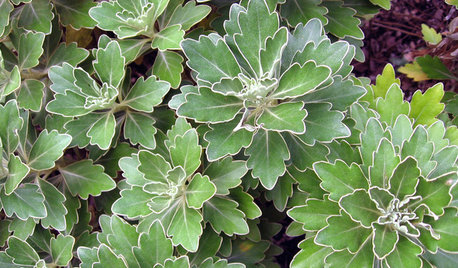The biggest Leaf ??
Anyone have an idea where the biggest leaf in the plant Kindom can be located ?? Species and / or location ?
Good Day ...
Comments (26)
Related Professionals
Erie Landscape Architects & Landscape Designers · Marina Landscape Architects & Landscape Designers · Bethlehem Landscape Contractors · Federal Way Landscape Contractors · Fuquay-Varina Landscape Contractors · Las Vegas Landscape Contractors · Selden Landscape Contractors · Anaheim Fence Contractors · Chandler Fence Contractors · East Haven Fence Contractors · Georgetown Fence Contractors · Maywood Fence Contractors · North Miami Beach Fence Contractors · Parkway Fence Contractors · Nipomo Fence Contractorslycopus
19 years agoVictoria amazonica, a waterlily, is a dicot and has entire leaves that can reach 6 feet in diameter. Hybrids of this and V. cruziana are reported to have leaves upwards of 8 feet in diameter. These leaves may be unique in that they can support the weight of a small person.
Bananas don't have the largest leaves of any monocot but they are still pretty impressive. I have also seen large specimens of Strelitzia regina (giant bird of paradise) that were awe inspiring, in a mall no less. The leaves were probably close to 8 feet long.
Josh
19 years agoFrom the marvelous site "Wayne's Word", a good explanation about various large leaves. Scroll down to No. 11, "Smallest and Largest Leaves". josh
Here is a link that might be useful: Largest Leaves
serenoa
19 years agoWayne's World is a great site. Palms have the biggest leaves. As Riffle states, Raphia regalis is the longest leaf. It is native to Africa. Corypha umbraculifera of India is a fan-shaped leaf that can span 30 feet. By the way, not everyone agrees with Lycopus that Victoria lilies are dicots. Recent classifications put them among the ancestral groups of monocots and dicots.
lycopus
19 years agoWhile some plants in the Nymphaeaceae are considered to be among the most primitive angiosperms, I have not seen widespread adoption of a classification scheme that puts them in a class other than Magnoliopsida. Are you referring to a recent paper?
The_Mohave__Kid
Original Author19 years agoHortus Third describes the family Nymphaceae as Dicots including Victoria...
Why would they be considered Monocotts ?
Good Day ...
serenoa
19 years agoHortus Third is a fine horticulural book but is not a taxonomic reference. Massive works like that are usually at least a little out of date by the time they are published. My reference for family level taxonomy is Plant Systematics: A Phylogenetic Approach by Walter Judd, et al from Sinauer & Associates Publishers. I have the first edition here at home and the second (latest) edition at work. My first edition puts them into a group in the class Angiospermopsida, called "non-monocot paleoherbs." I think they are called the "basal families" in the latest edition. I don't know if there is any formal designation is for this group. The idea is that these plants (including waterlilies, hornworts, pipers, and aristolochias) are directly descended from plants that preceded the evolution of monocots and dicots. I'm sure this is not the last word on the subject but it is a very interesting step forward.
The_Mohave__Kid
Original Author19 years agoLOL ... I'll admit Hortus Third is a getting old ... not as old though as Lawrences .. "Taxonamy Of Vascular Plants " my regular reference out of print in 1950's !!
This is interesting ... I will check out your reference maybe like to add it to the library.
I wonder what the evidence is for such a re ordering ?
Good Day ...
lycopus
19 years agoI don't have much of a background in taxonomy other than learning names and what I read here and there. However, aren't there many things that are still unknown about plant ancestry? I thought the purpose of the traditional Linnean hierarchy was to provide scientists with a universal system for the identification and classification of both known and newly discovered species. It always seemed to me that things like genetics and evolutionary relationships were regarded as most important at the level of the species and sometimes genera and family. Higher level taxa seem to be based on several factors, with morphology and phylogeny both playing a role. I suppose that optimally phylogeny would be the sole methodology, but can it ultimately create a system that will be useful to all botanists? Perhaps more than one taxonomic scheme would serve us better in the long run.
The_Mohave__Kid
Original Author19 years ago"However, aren't there many things that are still unknown about plant ancestry? "
Sure there is ... look at the scope of the project ... several hundred millions of years of evolution ... well over three hundred thousand plants .. hybridization .. ecotypes .. in 2004 we still don't know all the plants that live on the earth .. many going extinct before we ever get to look at them .. and technology changes everyday ... no system will stay the same forever ... I would think the fact our systems change is a sign we are moving ahead .. sharpening our view of the past ... and maybe clues to the future.
"I suppose that optimally phylogeny would be the sole methodology"
Not sure what you mean here ... phylogeny is the main goal since Darwin .. the methodology is whatever methods or evidence that lets you trace the phylogeny that is the evolutionary history ... of the organism or a structure in an organism.
Good Day ...
serenoa
19 years agoActually, plant systematics is a better term than taxonomy for the study of plant relationships. In Linneaus' time, gross morphology was the rationale for separating the known plants into groups. As the decades passed, microscopes, electron microscopes, chemistry, DNA studies and the discovery of many new plants gave new information to systematists. The time of identifying plants with nothing but characters observable in the field is passing us by. These new technologies are being applied to all of the traditional levels of taxonomy from the kingdoms to species. Because there are relatively few systematists in the world, it takes a long time to apply the new technologies to all of the different plants. So we see on-going, continual changes in scientific names and in the formal organizations of plant relationships as represented in orders, families and genera.
In fact, Lycopus, scientists don't always agree. We have more than one taxonomic scheme. It surprised me when I learned that plants can have more than one valid scientific name. We tend to follow the systems and names that are most widely accepted, but you can be scientifically correct in saying that you have studied the situation and chose to follow the scheme or name of a certain scientist. The problem is that most people will not understand.
Personally, I believe it is best to think of taxonomy and systematics as an inadequate, artificial system for catagorizing a very complex natural world. Accept that it is the best science can give us at this moment. Expect more changes as scientists struggle to get closer to the truth.
Unless you are a professional systematist, don't take it all too seriously. It will give you heart burn.
The_Mohave__Kid
Original Author19 years ago"Unless you are a professional systematist, don't take it all too seriously. It will give you heart burn."
It could ... but it can be quite a bit of fun reading how a evolutionary history has changed over time and to think about the different schools of thought .. something to do on a rainy day perhaps ... or maybe I need a more interesting life ??
Good Day ...
lycopus
19 years agoI do understand that it is all somewhat arbitrary. Using evolutionary theories to class plants is no more legitimate than using physical characteristics. There are just different ways of approaching the problem. I guess the only thing that bugs me is that continually restructing results is a mess of synonyms, and that is nearly as bad as the naming confusion that preceded Linnaeus. I found a reprint of his Species Plantarum at the library here and spent some time going through it. Unfortunately it was not translated, although most of the names were familiar and I could sort of work my way through it. It seemed like the concept of class, order, family etc. hadn't quite been worked out at the time. I recall the plants being grouped in some odd ways with things like monocots and dicots in the same groups. I couldn't find an index either (at least couldn't understand it if there was one) which made it all the more confusing. Still, it is remarkable that he was able to create something so detailed, although when you have complete control over the naming that must make it a little easier.
The_Mohave__Kid
Original Author19 years ago"I found a reprint of his Species Plantarum at the library here and spent some time going through it."
Very Cool ! What library was that.
"Using evolutionary theories to class plants is ** no more legitimate ** than using physical characteristics."
Using evolution is a lot more "legitimate" or more useful and informative ... perhaps this is the source of some of your discontent ... physical characteristics could and are used to support an evolutionary theory or theories .. Linnaeus had NO theory of evolution to work from ... he used physical characteristics as an organizing tool ... NOT to unravel the evolution of plant life and/or all of life on Earth in addition to Earths history ...
The theory of Evolution in general gives us powerful insight into not only how life has evolved but insight into how organisms including humans work and live and hence survive or die. It is evolution that really gives us insight into the concept of "Extinction" .. evolution is the foundation of modern biology.
Linnaeus .. was sitting on dynamite but never really lit the fuse to see the explosion .. think about it .. you may be on the verge of a major new insight ...
"I do understand that it is all somewhat arbitrary."
Not really true and I think perhaps this is hampering your view ... evidence must support any evolutionary theory proposed ... there is a matter of logic and emperical science involved here ... one can not hold on to an evolutionary theory that is not supported by evidence anymore then one can ignore the "Theory Of Relativity" .. properties of light .. gravity ect. ... there is an element of creativity in all of science to be sure and there are often divergent views .. but science .. evolution included ofcourse ... are NOT "arbitrary" .. hence things must change as we move on and learn more ... so in this sense following changes is quite exciting and well worth the burden of dealing with new names ect. .
I hope this makes some sense .. a pleasure talking with you.
Good Day ...
lycopus
19 years agoIt was at a college library here in NY. I have access because I am a returning student. Kind of neat but to be honest, looking at a lot of those old books is frustrating for the very reasons we've been discussing. Seems like every 10 years the information was out of date, and the taxonomy is the worst.
I didn't mean to impune evolutionary theory itself. What I meant is that using physical characteristics is an arbitrary system that is not subject to change without additional subjection. Whereas evolutionary thoeries are subject to change when better information comes to light. The decision to name plants based on evolutionary relationships was the arbitrary part. The logic of it is good though, and it would be perfect if there wasn't so much we didn't know about it. Maybe that is why it was adopted, to give us something to think about. It is just constantly subject to change and that makes it an odd way to name things.
To look at it another way, if I group scraps of paper by color, that is a perfect system of naming. Blue scraps will always be blue, orange will always be orange. That doesn't take into account the other properties of the paper though. I can draw other relationships based on many other properties, such as the thickness of the paper, the weight of the paper, the origin of the pulp, etc. There are endless possibilities. Now if I were to chose a property of the paper that was only partially known, I would be continually renaming them until all those properties were known. That is not to say that would not be more valid or even more interesting and ultimately more useful. However, I might suggest that the two paradigms be seperated for the purposes of clarity.
And yes, I think too much as well.
The_Mohave__Kid
Original Author19 years agoHello Lycopus ...
"if I group scraps of paper by color, that is a perfect system "
But what feature of plants is "perfect" and would allow for a perfect system for over 300,000 plants ?? Remember the number of organisms Linnaeus was up against was much smaller then we have today. He did a great job but the world past him by ....
"Maybe that is why it was adopted, to give us something to think about."
Yes .. I agree ... but even more so a system that can reveal what we don't know ?? Our system based on evolutionary histories is very informative as it lets us form many theories about the organisms in our world .. theories that would not be apparent if our system was "artificial" and it's more organized.
This is not to say "artificial systems" are not warranted .. such as "poisonus plants of South Carolina" for example ... but if we want to find plants that have simalar toxic qualities as lets say " Poison Ivy" we may do well looking in the genus Rhus and in the family Anacardiaceae the "Poison Ivy" genus and family rather the having these plants scattered around around collections based on some artificial system.
I would propose a system based on evolution is more productive then an artificial system and really less confusing ... and vital to our progress in science which is why we must keep our systems current and up to date even at the expense of some confusion just as we update our computer books.
Keep in mind some changes are just "house keeping" and not done in light of new dicoveries .. Example : two botanist finding and naming a new plant with different names at almost the same time. Well we can't have two names for the same plant so changes are made and this can lead to confusion in the literature. Ofcourse there are those that refuse to follow rules and use whatever names they wish to use in their publications.
Good Day ... ( from an ex New Yorker !! )
lycopus
19 years agoTo be fair, some authors disagree on names for good reason. My understanding is that if you have a legitimate reason for not adopting a new name and can justify it, you usually stand on pretty firm ground. I have noticed that many varieties are not recognized by all authors, or in some cases the varietal differences are disputed. The reasons stated are often good ones.
Poison ivy is a good example actually. Poison ivy is considered to be in the genus Toxicodendron now. One variety of the eastern poison ivy, Toxicodendron radicans var. rydbergii (eastern poison oak) is considered by some to be a distinct species, T. rydbergii. It occurs in some of the same habitats as the regular poison ivy but is also better adapted to very dry sandy soils and has a different habit. It's more of a spreading ground cover while regular poison ivy is a vine. I wrote a paper on poison ivy once and wasn't sure how to treat this species, since to me both classifications had merit. More than likely the two can interbreed, which by some criteria would make them the same species. However, how many species of plants exist that can interbreed and produce fertile offspring? It would be quite a mess to create thousands of new varieties to deal with this discrepency.
It is all rather confusing. I found a great book on lichens and found that there are some 35,000 named "species" of lichens, even though all lichens are composed of at least two species from different kingdoms!
The_Mohave__Kid
Original Author19 years ago"However, how many species of plants exist that can interbreed and produce fertile offspring? "
Eeek ... even plants from different genera can breed !!! Sex is not tidy in nature.
Have you checked out " Evolutionary Biology Of Plants" by Niklas. The world is not a simple plce.
Good Day ...
nazanine
19 years agoI stumbled on a post on the Orchid forum with this link :)
Here is a link that might be useful: giant leaf
bradmm
19 years agoWhat about Amorphophallus titanum?
The picture below was taken at Kew and that's my unsuspecting wife snuggling up to it. ;-)
Here is a link that might be useful: {{gwi:433902}}
rlriffle_FL_zone10
19 years agoAmorphophallus titanum does not have the world's biggest
leaf although it is immense.
The "media" are wont to declare that it has the world's
biggest flower but this is also untrue, and false in two
senses: what they are calling a flower is, in fact, an
inflorescence containing very many small flowers--the
central cone that bears the blossoms is called a "spadix"
and the colored, flanging giant 'petal' is the spathe;
and it's not even the world's largest inflorescence,
the distinction belonging, again, to a palm (already
mentioned), Corypha umbraculifera. The latter species'
inflorescence forms (unlike those of most palm genera)
atop the trunk, results in the death of the giant
single trunked species, and can attain 15 feet of height
and 20 feet of width, with many millions of small
flowers.bradmm
19 years agorlriffle_FL_zone10,
You stated that the Amorphophallus doesn't have the biggest leaf and went on to address the issue with the inflorescense but the topic of the thread is "The biggest Leaf ??" If it's not the biggest leaf, can you tell us what is? I'm still curious.
rlriffle_FL_zone10
18 years agoBrad, please see the msg I posted on Nov 6 of last year,
near the "top" of this thread.In case anyone is interested, I believe the world's largest
flower (not part of an inflorescence) is still considered
to be that of the Malaysian parasitic vine Rafllesia
arnoldiana at about three feet in diameter.Kaveh Maguire Garden Design
18 years agoThey had big pickled specimens of Raffllesia flowers in the Botanical Garden in Kyoto.
They are freakishly big and bizarre. :)

















rlriffle_FL_zone10